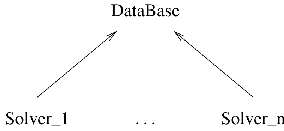Chapter I.1
Generic “DataBase” class
Basically, a “DataBase” class is a container used to store a finite element model, Groups, Results,
and other less important entities. The DataBase class also allow to retrieve, manipulate or
modify these objects. The DataBase class is a generic class that cannot be instantiated. The
specialized classes that inherit the generic DataBase class are described in Part III. Other
solvers might be supported in the future. The class hierarchy is schematically represented in
Figure I.1.1.
As three classes are represented in Figure I.1.1, the methods described in this Chapter may belong
to the generic DataBase class or to the derived classes. A few basic principles should help the user to
“guess” in which class some of the methods are defined:
- All methods related to the definition of the model stored in the DataBase are defined in
the specialized classes.
- All methods related to the reading of Results from solvers output files are defined in the
specialized classes.
- Most methods for the manipulation of Groups and of Results are defined in the generic
“DataBase” class.
Throughout the Chapter one specifies for the different methods, in which class they are defined. This
Chapter is divided in several sections:
- One presents in section I.1.1 the methods devoted to the initialization of the finite
element model in the DataBase.
- Section I.1.2 is devoted to the DataBase’s methods devoted to the manipulation of
Groups.
- Section I.1.3 is devoted to the DataBase’s methods devoted to the manipulation of
Results.
- In section I.1.4, the manipulation of abbreviations stored in the DataBase is described.
- The interaction of CLA classes with DataBase classes is discussed in section I.1.5.
- The iterators of Class DataBase are described in section I.1.6.
- Finally, general purpose methods are presented in section I.1.7.
A list of the methods defined in “DataBase” class is given in Table I.1.1.
